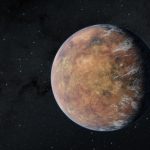Key Takeaways:
- Astronomers have discovered a distant planet possibly covered entirely by a deep water ocean, advancing the quest for habitable environments beyond Earth.
- Observations by NASA’s James Webb Space Telescope detected water vapour and chemical signatures of methane and carbon dioxide in the exoplanet’s atmosphere.
- The planet, named TOI-270 d, is approximately 70 light years away, twice the size of Earth, and exhibits characteristics of a water world with a hydrogen-rich atmosphere.
- Conflicting interpretations exist regarding the planet’s habitability, with some suggesting a potentially habitable “hycean” world while others propose extreme conditions unsuitable for life.
- Further research is needed to clarify the presence of an ocean and assess the likelihood of habitability on TOI-270 d, highlighting the importance of continued exploration of exoplanetary environments.
A distant planet that could potentially be completely covered by a deep ocean of water has been spotted by astronomers, a discovery that advances the search for habitable conditions beyond Earth.
The findings, made possible by NASA’s James Webb Space Telescope (JWST), reveal the presence of water vapour and the chemical signatures of methane and carbon dioxide within the exoplanet’s atmosphere. Situated approximately 70 light years away and boasting twice the radius of Earth, this celestial body presents a chemical composition consistent with that of a water-dominated world, enveloped by a hydrogen-rich atmosphere. However, researchers from the University of Cambridge caution against imagining it as a tropical, inviting seascape.
Professor Nikku Madhusudhan, who led the analysis, suggests that the temperature of the ocean could exceed 100 degrees Celsius. Even under high atmospheric pressure, such heat levels might maintain the ocean in a liquid state, but its habitability remains uncertain.
Published in the journal Astronomy and Astrophysics Letters, this interpretation is challenged by a Canadian research team. They argue that the temperatures on the exoplanet, known as TOI-270 d, would be too extreme for liquid water, potentially reaching a scorching 4,000 degrees Celsius. Instead, they propose a scenario where the planet possesses a rocky surface beneath an immensely dense atmosphere composed of hydrogen and water vapour.
Despite the differing interpretations, these recent observations highlight the significant insights provided by the James Webb telescope into the characteristics of planets located beyond our solar system. By analyzing starlight that has traversed through the atmospheres of these distant worlds, astronomers gain a comprehensive understanding of their chemical compositions, shedding light on the potential habitability of these alien environments.
The hypothesis suggesting an oceanic world is supported by the absence of ammonia in TOI-270 d’s atmosphere, a chemical that basic chemistry principles would predict to be present in a hydrogen-rich atmosphere. However, as ammonia is highly soluble in water, its absence in the atmosphere could imply the existence of an ocean beneath the hydrogen-rich veil. Professor Madhusudhan refers to this scenario as a “hycean” world, characterised by a water ocean beneath a hydrogen-dominated atmosphere.
The conditions on TOI-270 d would starkly contrast with those found on Earth. Tidally locked, with one side eternally facing its parent star and the other shrouded in perpetual darkness, the planet experiences extreme temperature differentials.
Professor Björn Benneke, from the University of Montreal, challenges the “hycean world” hypothesis, arguing that temperatures on the planet would be too high for liquid water to exist. His observations suggest surface temperatures of up to 4,000 degrees Celsius, with water potentially existing in a supercritical state, blurring the distinction between liquid and gas.
Both research teams detected carbon disulphide, a molecule associated with biological processes on Earth, though its presence does not definitively indicate the presence of life. Further investigations are warranted to ascertain the abundance of water vapour in the atmosphere and to clarify the likelihood of an ocean on TOI-270 d.
Dr Jo Barstow, an astronomer at the Open University, underscores the importance of these observations, noting the need for additional research to elucidate the unique environments of these distant planets, which lack counterparts in our own solar system.


